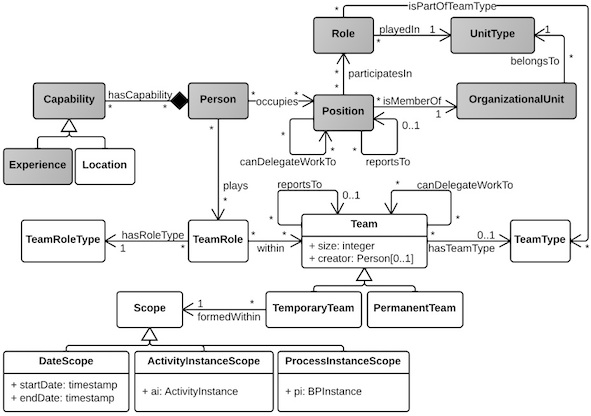We propose team-related extensions to the organisational metamodel described by Russell et al. for the definition of the WRPs, based on observations from several domains, e.g. healthcare, software development and military missions. The figure below depicts the team-aware organisational metamodel, where former entities are coloured in grey and team-related concepts in white. A Team is a set of people collaborating in the completion of a specific activity with a common objective. A person is member of a team due to playing a role in the team (class TeamRole), e.g. coordinator of Perm_RE_1. Each team role has a specific TeamRoleType according to types explicitly defined in the company, such as investigator, coordinator, implementer or specialist. It has to be emphasized that team roles are fundamentally different from organisational roles. In an example we described in the paper submitted to CAiSE 2014, Nick occupies the position DoG_Doctor and participates in organisational roles Doctor and Assistant, but within team Perm_RE_1 he has the team role of Coordinator for Perm_RE_1 (of type Coordinator) and the team role of Implementer for Perm_RE_1 (of type Implementer).
A team can have a type (class TeamType) that is associated with a specific configuration of the organisational roles. For example, in the motivating scenario there are teams Perm_RE_1 and Perm_RE_2 of type Routine Examination, composed of a doctor and an assistant. Team type Advanced Tests is made up of a doctor, an assistant and a nurse. More teams of these types could be created with the same role configuration. There could also be a team type Heart Surgery made up of two doctors, two assistants and one nurse, for instance. In this way, team types provide templates for the composition of teams.
Teams can also be structured hierarchically. For example, in SW development, there are often teams of SW Analysts (composed of persons with role Analyst), teams of SW Developers and teams of SW Testers. The team of analysts delegate work to the teams of developers, which report issues and results to the former and, in turn, delegate work to the team of testers. These report the results to the developers. In this context, modes of communication between teams have to be established, which we do not directly address here.
Finally, teams are also classified according to their temporality. A PermanentTeam is defined without a expiry date. Permanent teams can be referenced by their identifier at any moment. However, in certain occasions new teams are composed for specific purposes. For instance, in emergency surgeries teams are created, modified and broken up constantly depending on the requirements of the operations. Such teams are called TemporaryTeams because they have a expiry date defined as a specific scope. The scope can be (i) a specific period of time, e.g, a team active from August 1st to August 31st to provide support during the summer holiday break; (ii) it can be associated to a single activity instance, e.g. the execution of a single surgery; or (iii) it can be related to a process instance, so that the team can be treated as a single entity during the execution of the process instance because their participation could be required at any moment. Further team classifications are proposed in literature that mostly focus on how teams organise themselves (e.g. their coordination mechanism). However, they are not included in the metamodel because our focus is on those aspects that are relevant for team selection in the context of resource assignment.
A person is a team creator if she is in charge of its configuration and of recruiting its members. She is not necessarily a member of the team, though. Besides, the figure of team creator is not mandatory, as teams may be automatically composed by a system according to some properties defined for them.
It is important to remark the difference between an OrganisationalUnit and a PermanentTeam. Although both are groups of people with an indefinite duration, the former is not an entity of collaborative work with a single goal by nature, but is composed of members that participate in different activities, each of which has a specific objective. In case of assigning concrete work to an organisational unit, it is because the unit is working as a team in the context of an activity or process, i.e., there is a new team made of the members of the organisational unit. For instance, if a hospital is organising an event, each department (i.e., organisational unit) could form a team working on the preparation of a specific issue (i.e., in that moment all their members have a common goal). Such a distinction has been described before in literature.













